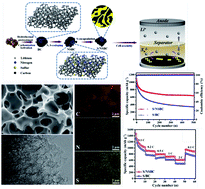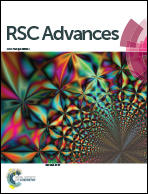Nitrogen, sulfur-codoped micro–mesoporous carbon derived from boat-fruited sterculia seed for robust lithium–sulfur batteries†
Abstract
The diverse textures and tunable surface properties of abundant bioresources offer great opportunities to utilize biochar materials as sulfur hosts for naturally boosting the electrochemical performances of Li–S batteries. Herein, a N, S-codoped micro–mesoporous carbon was synthesized from boat-fruited sterculia seed, and used as a sulfur host matrix for Li–S batteries. After sulfur infiltration (≈62% sulfur) and cell assembly, the obtained S/NSBC cathode shows outstanding discharge–charge performance, good rate capability, and especially long cycling stability. A high initial discharge capacity of 1478 mA h g−1 was achieved at 0.1C, and the reversible discharge capacity was still retained at 649 mA h g−1 after 500 cycles at 0.5C with ultralow decay rate of 0.08% per cycle, and especially zero-capacity-decay after 300 cycles. Such superior electrochemical performance of S/NSBC cathode is attributed to the synergy of the unique 3D conductive micro–mesoporous frameworks and huge N, S-codoped polar surface within the carbon matrix, which can physically confine the dissolved polysulfides within the pore structures, and chemically anchor the polysulfides through chemical interaction between lithium polysulfides and N and S sites, thus enabling the favorable reaction kinetics, efficient utilization of sulfur, and effective mitigation of polysulfide diffusion and shuttling within the cathode. This work well manifests the great feasibility and superiority of utilizing bioresources for high performance Li–S batteries.



 Please wait while we load your content...
Please wait while we load your content...